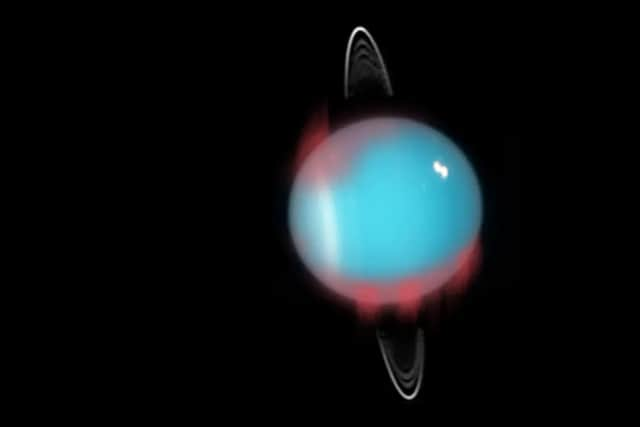Uranus: scientists discover infrared aurora that may provide clues to habitable icy worlds
This article contains affiliate links. We may earn a small commission on items purchased through this article, but that does not affect our editorial judgement.
and live on Freeview channel 276
Uranus' infrared aurora has been spotted for the first time by scientists using the giant Keck II telescope on Mauna Kea in Hawaii. The planet's counterpart ultraviolet aurora was first detected in 1986 by Nasa's Voyager 2 probe, which flew by in the same year.
The researchers said the discovery could shed light on "the mysteries behind the magnetic fields" and even on whether distant worlds might be able to support life. The ice giants in our solar system, Uranus and Neptune, are unusual as their magnetic fields are misaligned with the axes in which they spin.
Advertisement
Hide AdAdvertisement
Hide Ad

Similar to auroras on Earth, Uranus' is caused when charged particles in the solar wind interact with the planet's magnetic field and are pushed towards its magnetic poles. They then enter the atmosphere and collide with atmospheric molecules, causing those molecules to glow.
Uranus' dominant atmospheric gases are hydrogen and helium at lower temperatures than those on Earth, which leads to its glow being predominantly at ultraviolet and infrared wavelengths. The research was published in Nature Astronomy titled "Detection of the Infrared Aurora at Uranus with Keck-NIRSPEC."
Graduate student Emma Thomas of the University of Leicester used data from the Keck II Near-Infrared Spectrometer (NIRSPEC) in 2006 to identify emission lines from the H3+ molecule - a trihydrogen cation containing three protons and only two electrons making it positively charged. The emission came from molecular hydrogen being ionized and forming H3+ cations following collisions with charged particles, which created Uranus' northern lights.
In a statement, Thomas said: "The temperature of all the gas giant planets, including Uranus, are hundreds of degrees Kelvin/Celsius above what models predict if only warmed by the sun, leaving us with the big question of how these planets are so much hotter than expected. One theory suggests the energetic aurora is the cause of this, which generates and pushes heat from the aurora down towards the magnetic equator.
Advertisement
Hide AdAdvertisement
Hide Ad"A majority of exoplanets discovered so far fall in the sub-Neptune category and hence are physically similar to Neptune and Uranus in size. This may also mean similar magnetic and atmospheric characteristics too. By analysing Uranus's aurora which directly connects to both the planet's magnetic field and atmosphere, we can make predictions about the atmospheres and magnetic fields of these worlds and hence their suitability for life."
Comment Guidelines
National World encourages reader discussion on our stories. User feedback, insights and back-and-forth exchanges add a rich layer of context to reporting. Please review our Community Guidelines before commenting.
